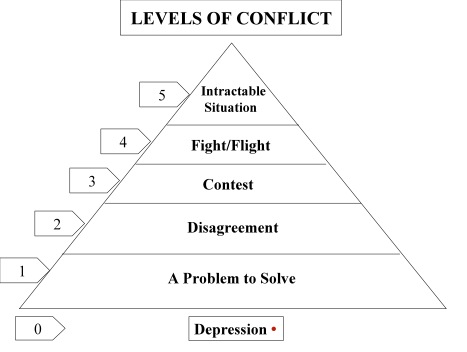
Level 1 - Problem to Solve
- Everyday frustrations and aggravations
- People have different opinions, misunderstanding may have happened
- Conflicting goals or values
Words used
- Clear, specific, and factual
- Language is on the now, not talking about the past
- People check in with one another if they think a miscommunication has just happened
- It’s not comfortable, but it’s not emotionally charged either
Level 2 - Disagreement
- Self-protection becomes as important as solving the problem
- People distance themselves from one another
- People talk offline with other people to test strategies or seek advice and support
- Good natured joking moves toward half-joking barb
- Nastiness gets a sugarcoating but still comes across as bitter
- People are wary
Observations on conversations
- Language moves from specific to general
- Conversations change to make room for self-protection
- What’s not being said gives as many clues as to what is being said
- People don’t share all they know about the issues
“Yes I broke the build, but I think we need to look at the bigger picture”
“You are doing the same thing you did last time that didn’t work”
Level 3 - Contest
- People aim to “win”
- Compounding effect occurs as prior conflict and problems remain unresolved
- Multiple issues cluster into larger issues or create a “cause”
- People begin to aligning themselves with one side or the other
- Emotions become tools used to “win” supporters for one’s position
- Problems and people become synonymous
Observations on conversations
- Language becomes distorted
- Over generalizations, presumptions, magnified positions
- Real issues get lost
“If only she weren’t on the team”
“He always talks in minute detail”
“They always take shortcuts”
“I don’t even know what we are trying to solve right now”
Level 4 - Crusade
- Resolving the situation isn’t good enough
- You may believe the only option is to remove the others from the team or get removed from the team
- Factions become entrenched and can solidify
- People and positions are seen as one
- Overall attitude is righteous and punitive
Observations on conversations
- Conversations become more idealogical
“They’ll never change so it’s not even worth talking to them”
“We’re right”
“They wrong, plain and simple”
Level 5 - World War
- Destroy!
- It’s not enough that one wins, others must lose
- No constructive outcome can be had
Observations on conversations
- Why talk when we can hit each other
“We have to win”
“It’s us or them”
What to do in conflict
- Don’t react to every whim of a conflict - some levels of conflict naturally diffuse with time
- Focus on language during conflict,
Things to do
- Feel the energy in the room
- Focus on language
References
Coaching Agile Teams Book
5 levels of conflict
Want less conflict? Do nothing

